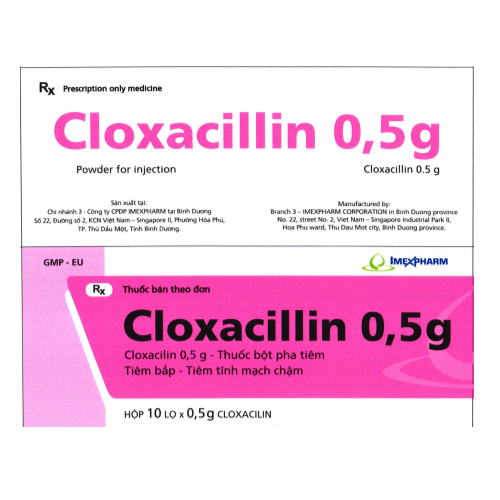Uses of Aztreonam
Aztreonam contains the active ingredient Aztreonam - an antibiotic of the beta - lactam group, indicated in the treatment of infections caused by sensitive bacteria such as urinary tract infections, blood infections, bone and joint infections..
.
.
1. What is Aztreonam?
Aztreonam medicine contains the active ingredient Aztreonam, an antibiotic of the beta-lactam group, which is prepared in the form of a powder for injection and solution for infusion. Aztreonam is indicated in infections caused by susceptible bacteria as follows:
Urinary tract infections, blood infections; Skin and soft tissue infections, bone and joint infections; Lower respiratory tract infections; Abdominal infections; Gynecological infections due to gonorrhea or gram-negative bacteria; Fever accompanied by neutropenia (in combination with the antibiotic Vancomycin).
2. Dosage of the drug Aztreonam
Aztreonam is an antibiotic in the group of prescription drugs used by injection. Therefore, the dose of the drug should be prescribed by the doctor depending on the infection status, the patient's ability to absorb. The recommended dosage of Azreonam is as follows:
Adults:
Urinary tract infections: 500mg - 1g every 8-12 hours intravenously or intramuscularly; Moderate to severe systemic infections: Administer 1g-2g Aztreonam intravenously every 8-12 hours. In case of life-threatening infections (especially those caused by P.aeruginosa) 2g intravenously every 6-8 hours. Children:
Children 9 months of age and older with normal renal function 30 mg/kg IV every 8 hours for mild to moderate infections, 30 mg/kg every 6-8 hours to Treatment of moderate to severe infections. The maximum recommended dose of Aztreonam is 120mg/kg/day. In the case of patients with cystic fibrosis of the pancreas, the dose can be increased to 50mg/kg every 6-8 hours; Children under 1 week of age (weighing less than 2kg): Use a dose of 30mg/kg every 12 hours or 30mg/kg every 8 hours in children weighing more than 2kg; Newborns from 1 to 4 weeks old: 30mg/kg every 8 hours or every 6 hours for children weighing more than 2kg; Children weighing less than 1.2 kg should be given a dose of 30 mg/kg every 12 hours. Other subjects:
Elderly: The dose of Aztreonam in the elderly depends on renal function (creatinine clearance). In case the patient has a creatinine clearance greater than 30ml/min/1.73m2, no dose adjustment is required. In case the patient has a creatinine clearance of 10-30ml/min, the loading dose is 500mg, 1g or 2g, then the maintenance dose is 1⁄2 of the loading dose. In case the patient has creatinine clearance less than 10ml/min, take the first loading dose with the usual dose, the maintenance dose is equal to 1⁄4 of the usual dose; People performing hemodialysis: Because Aztreonam can be removed by hemodialysis, patients on hemodialysis need an additional dose of Aztreonam equal to 1⁄4 of the loading dose immediately after each hemodialysis session; People performing peritoneal dialysis: The dose of Aztreonam is the same as the usual dose, then the maintenance dose is equal to 1⁄4 of the loading dose; Hepatic impairment: It is recommended to reduce the dose of Aztreonam by 20-25% in patients with alcoholic cirrhosis, especially in the case of prolonged use of Aztreonam.
3. Side effects of the drug Aztreonam
Aztreonam can cause some side effects as follows:
Common: Injection site reactions such as irritation, diarrhea, rash, vomiting, nausea; Uncommon: Oral ulceration, altered taste, increased risk of bleeding, erythema multiforme, exfoliative dermatitis, vaginitis, Candida infection; Rare: Chest pain, anaphylaxis, myalgia, headache, fever, increased prothrobin time, eosinophilia, thrombocytosis, anemia, hemorrhage, hypotension, ECG abnormalities, confusion, paresthesia, tinnitus...
4. Note when treating with Aztreonam
4.1. Contraindications Contraindicated to use Aztreonam in patients with a history of allergy to Aztreonam or to any beta-lactam antibiotic, pregnant patients.
4.2. Precautions for use Before being treated with Aztreonam, the patient should inform the doctor about the history of drug allergy, especially to the beta-lactam antibiotics.
Treatment with Aztreonam may result in overgrowth of non-susceptible organisms (especially Gram-positive bacteria) or fungal overgrowth. Therefore, the patient should be closely monitored, and the case of superinfection should be treated immediately.
It is important to distinguish diarrhea caused by Aztreonam from diarrhea caused by Clostridium difficile.
Caution when using Aztreonam in patients with liver failure, kidney failure. Reduce dose and frequency of administration in patients with renal impairment, check liver function once a week.
The efficacy and safety of intravenous Aztreonam in children 9 months of age and younger have not been fully established.
Pregnant women: Aztreonam is contraindicated in pregnant women.
Lactating women: Small amounts of Aztreonam may be excreted in breast milk. Although Aztreonam is poorly absorbed from the gastrointestinal tract, it is not recommended to use the drug in lactating women.
5. Drug interactions
Aztreonam drugs can cause some interactions as follows:
Synergistic effect when using Aztreonam with Aminoglycoside antibiotics in the treatment against blue pus bacillus and some Enterobacteriaceae (E.Coli, Serratia, Klebsiella..); Concomitant use of Aztreonam with beta-lactam antibiotics (cefoperaxon, piperacillin) provides additive or synergistic antibacterial effects; Using Aztreonam and Clindamycin for synergistic antibacterial effects on Klebsiella, E.coli and Enterobacter; Combined use of Aztreonam and Clavulanic Acid for a synergistic effect against Klebsiella, Enterobacter, Bacteroides fragilis. Aztreonam is incompatible with Cephradin, Nafcilin, Vancomycin, Metronidazol, so these drugs need to be used separately. Above is the complete information about the drug Aztreonam. Patients should carefully read the instructions for use before use.
Để đặt lịch khám tại viện, Quý khách vui lòng bấm số HOTLINE hoặc đặt lịch trực tiếp TẠI ĐÂY. Tải và đặt lịch khám tự động trên ứng dụng MyVinmec để quản lý, theo dõi lịch và đặt hẹn mọi lúc mọi nơi ngay trên ứng dụng.
Bài viết này được viết cho người đọc tại Sài Gòn, Hà Nội, Hồ Chí Minh, Phú Quốc, Nha Trang, Hạ Long, Hải Phòng, Đà Nẵng.






